Earth elements
Join the sustainability effort with these local environmental causes and organizations
City of Tulsa Recycling
Since launching a new recycling program in 2012, the City of Tulsa is attempting to reverse non-recyclable contamination in residential blue carts. The current rate of contamination is nearly 22 percent; the long-term goal is to reduce it to 15 percent. The four recyclable materials—empty and clean steel and aluminum cans, cardboard and paper, rigid plastics (#1–#7 only), and glass jars and bottles—are easy to remember. Contamination items like plastic bags, paper towels, Styrofoam, ceramics, and aluminum foil are easy for residents to overlook. Those go in the trash, but you can recycle plastic bags at Reasor’s.
The City recommends that aluminum cans not be crushed, and shredded paper must be placed in a sealed clear plastic bag (paper shreds are the only items that can be bagged and placed in the cart). A full list of non-recyclable materials can be found at cityoftulsa.org. A high contamination rate costs the city and residents money, since every non-recyclable has to be manually sorted out and cannot be processed at the recycling center. Their recommendation: “When in doubt, throw it out.”
According to the City, up to 80 percent of a household’s waste is recyclable. By reducing the amount of trash that goes into the gray trash cart, you can request a smaller cart and pay less for waste removal. Unfortunately, curbside recycling is not offered at most apartment complexes, but residents can haul their recyclable materials to one of the Metropolitan Environmental Trust’s 12 drop-off facilities. The M.e.t. also accepts electronics, batteries, and compost. For locations, visit metrecycle.com.
The City of Tulsa Household Pollutant Collection Facility (4502 S. Galveston Ave.) accepts drop-offs by appointment only (918-591-4325). They process fluorescent and CFL lightbulbs, oil-based paints and paint thinner, flammable liquids, lawn chemicals, automotive fluids, cooking oil and grease, aerosols, household and car batteries, household cleaners, pool chemicals, electronics, and mercury thermometers. It’s important that pollutants and chemicals be disposed of in a proper way to protect Tulsa’s environment, residents, and City workers.
Everyone can improve their recycling practices by sticking to the four materials and making sure their recyclables are clean. Unclean recyclables count as contamination too; for example, the only part of a pizza box that can be recycled is clean cardboard—any other inserts or food waste should be thrown out. —Mason Whitehorn Powell
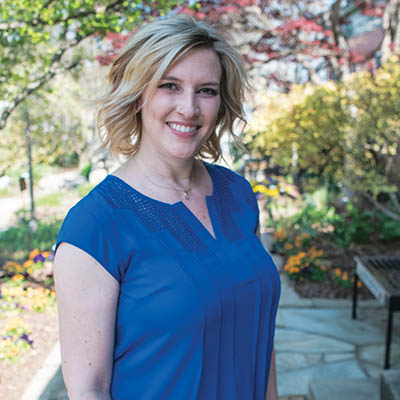 Laura Koval: Master Gardener
Laura Koval: Master Gardener
Laura Koval is a lifelong horticulturalist. As a certified Master Gardener, she works to educate Tulsans about urban gardening. You can find more information at tulsamastergardeners.org.
Fraser Kastner: How long have you been gardening?
Laura Koval: For as long as I can remember. I grew up in a family of gardeners, so it’s just been something I’ve always done. As I got older I always stuck with it and always had something growing.
Kastner: How did you become an official Master Gardener?
Koval: They hold interviews in August of each year. You go into the OSU Tulsa County Extension Center and listen to a quick overview of the services a Master Gardener provides. Once you get into the program you take weekly classes. You learn about the most common things: flowers, vegetables, trees. You also learn about different types of soils and composting, and they have great speakers come in. It’s an excellent educational experience for anyone who enjoys gardening.
The classes are from September through about mid-December, and then you do an internship for a year. During that year they have different requirements and classes that they want you to fulfill and some events they want you to participate in to learn the ins and outs of the program. Then you just do your 70 volunteer hours, and you’re official after that.
Kastner: What do you do as a Master Gardener?
Koval: They have all kinds of programs. They do school groups, they have the Senior Living Outreach Program, which worked with Habitat for Humanity. And you’ll see [Master Gardeners] at events, answering questions. My favorite thing to do is with the Tulsa Master Gardeners Speakers Bureau. I’ve been teaching some of their urban gardener classes. Anyone can go on the Master Gardener website and request a certain [event] topic.
Kastner: What might people be surprised to learn about being a Master Gardener?
Koval: I think people would be surprised at how active the program really is in the community. I was shocked at the number of people who commit so much time to helping out. They do Tulsa Blooms!, which [places] flower pots in Brookside and the Blue Dome District. I think it’s a lot more impactful than people recognize.
Kastner: What grows well in Oklahoma?
Koval: I think it’s a great climate to vegetable garden in—that’s mostly what I do now. You get a really long season, from February through December.
Kastner: Where would you point someone who wanted to get more involved in the Master Gardener program?
Koval: You can get all the information on the website. If you want to brush up on your gardening skills or get more involved in a certain topic, all of our classes are listed there. —Fraser Kastner
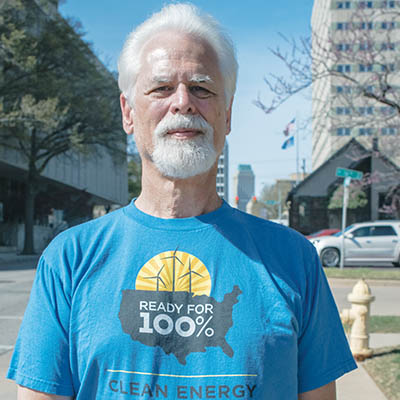 Gary Allison and Ready for 100
Gary Allison and Ready for 100
Law professor Gary Allison has been a tireless advocate for clean energy and environmental protection in Oklahoma since the mid ‘70s. He began his teaching career at The University of Tulsa in 1974, one year after Public Service Company of Oklahoma (PSO) announced its plans to build the Black Fox nuclear power plant three miles from downtown Inola. The project gained the support of initially reluctant residents through promises of thousands of jobs and significant economic growth. Not everyone was convinced.
Inola farmer and teacher Carrie Dickerson heard about the plans to build the facility just a few miles from her family farm and began researching the potential environmental impacts. What she learned about potential radiation leaks and contaminated water disturbed her so much she formed the political action group Citizen Action for Safe Energy. Dickerson enlisted Allison as an invaluable advisor in their ensuing legal battle. Eventually the group halted the construction of the plant.
Allison, however, downplayed his role in the group’s success.
“I’m not the big hero in this; the big hero was Carrie Dickerson,” Allison said. “Carrie and her husband mortgaged their farm to pay for some really great lawyers who fought this tooth-and-nail in front of the nuclear regulatory commission.”
Knowing they wouldn’t win on environmental implications alone, Allison helped the group to write a report on the financial feasibility of nuclear power plants. They pointed out that nuclear power was not only environmentally unsustainable—it was also too expensive.
“I had come to the belief that we probably weren’t going to win in a state like this [unless] people thought it would drive up their utility bills. In the end that’s what [won] it [for us],” Allison said.
In 1986, at a time when Oklahoma was struggling with a deep downturn in oil prices, Allison ran against Jim Inhofe in the 1st Congressional District. A banner issue in Allison’s campaign was the need to provide working solutions to broaden the state’s economy so it wouldn’t be completely dependent on the oil and gas industry. Allison lost the election, earning 43 percent (to Inhofe’s 55) of the votes.
But Allison continued to fight for economically viable clean energy and continues to this day through his leadership in the Ready for 100 campaign, an initiative that aims to transition from coal and gas resources to 100 percent clean energy, like solar and wind.
“We’re about fifth in the nation for wind production, within the top ten,” Allison said. “If it weren’t for some negative state laws, we could be one of the top five in solar. We have really good wind and solar resources here. There’s no reason why we can’t be in the top five of both of them.”
Tulsa, Edmond, and Norman are three of 164 U.S. cities with Ready for 100 campaigns. Five of the 164 have achieved the goal of 100 percent clean energy.
“Right now [our goal] is to build our organization and our campaign structure. We’ll soon be involved in conducting interviews in each of the council districts in order to have an understanding of where people are in their lives [with energy use] and their knowledge of renewable energy,” said Allison.
Allison is currently the director of the sustainable energy and resources law program at TU but will soon retire so he can commit his time to Ready for 100.
“I vowed when I retired that I would do all I could to help make sure that climate change would not affect the people coming after me,” he said.
For more information on Ready for 100, visit sierraclub.org/ready-for-100. —Mary Noble
Fab Lab Tulsa
Fab Lab Tulsa is helping Tulsans rethink the way they consume and use products by giving them a chance to construct their own. Fabrication labs were first thought up by a professor at MIT who found that when he supplied his students the tools and instruction to create freely, they were capable of producing impressive and practical items. Since then, fab labs have gone global, and Tulsans have the chance to fabricate according to their own diverse interests. Commercial products, prototypes, artistic works, educational projects, and items of personal interest (like small battery-powered LED lamps or 3-D-printed poop emojis) are all creations they’ve seen at Fab Lab Tulsa. Members can reserve machines online, use free Computer Aided Design software, and attend software and hardware instruction classes hosted by Fab Lab staff members. Nonmembers can also register for classes, like the Make & Take course, in which students are led through a digital fabrication project-building exercise. Courses are novice-friendly, so don’t worry about getting in over your head. Once you are familiar with the machinery and software, invention is only limited by your own imagination. Makers at Fab Lab are making more and buying less—some of the most impressive designs made at Fab Lab Tulsa include 3-D-printed surgical tools, a prosthetic hand, and a 15’ canoe. Whether you have the mind to make custom furniture, architectural models, or even cosplay garb, you can do it at Fab Lab Tulsa—and they hope you will. The lab is designed to promote innovation, entrepreneurship, and change-making. Fab Lab’s leaders hope to someday see large 3-D printers widely available in communities, diminishing the need for shipping products—ideally, no product would exist until it is ordered. This would change consumer and shipping industries, alter the way we think about supply and demand, and ensure that very little is built only to go to waste. But until that far-flung future, Fab Lab Tulsa is here to satisfy your more innovative desires. Visit fablabtulsa.org for more information. —Trent Gibbons
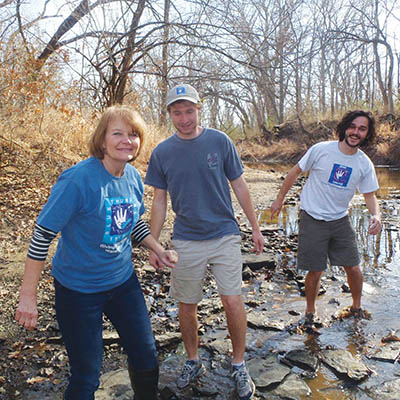 Blue Thumb
Blue Thumb
Blue Thumb is a citizen science program that trains Oklahomans to monitor creeks and streams and to share their knowledge of water quality with the public. The ultimate goal of Blue Thumb, which is funded by the EPA Section 319 Program, is to protect Oklahoma’s water from nonpoint source pollution. This type of pollution results from land runoff, precipitation, atmospheric deposition, drainage, seepage, or hydrologic modification. Blue Thumb is working in partnership with the Oklahoma Conservation Commission on several creek and stream recovery projects.
Over 300 volunteers work to oversee 100 Oklahoma streams, checking the effects of stormwater runoff on water quality. Monitoring is a 4-step process, involving biological, chemical, and physical monitoring and quality assurance/data interpretation. Volunteer-written data interpretations of many creeks and streams are accessible on an interactive map on their website, bluethumbok.com.
Anyone can become a Blue Thumb volunteer by attending the organization’s volunteer training course. Several are held throughout the year across the state, and a group of ten or more interested people can request a scheduled special training session.
Blue Thumb also offers Project WET, a water education program for K–12 teachers. The WET sessions not only promote awareness but also provide teaching materials and a certificate for six professional development or continuing education hours.
On July 10, Blue Thumb is partnering with Grand River Dam Authority, OSU 4-H, Ag in the Classroom, and OU’s Oklahoma Water Survey for an open three-day educators’ workshop, Riverology 101, in Langley. Online registration is open now.
Volunteering with Blue Thumb is a great way for Oklahomans to be directly involved in protecting their local environment. Citizens can take something as important as water quality monitoring into their own hands rather than relying on institutions to do the work for them. —Mason Whitehorn Powell
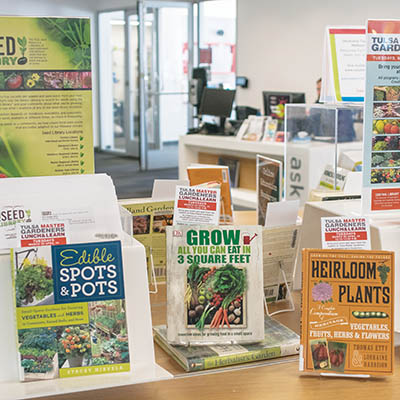 TCCL Seed Library
TCCL Seed Library
Tulsa City-County Library’s Seed Library is diversifying the city’s ecology by expanding access to and offering free garden seeds. Any inspired gardener is welcome to check out seeds from the robust collections at any one of 10 locations. After growing their garden, participants are highly encouraged—but not quite required—to return to the library with seeds of their choice. This creates a no-stress system for seed checkout; seeds are “due” within six months of rental, but gardeners will never actually be fined for overdue seeds. The Seed Library also hosts events to help cultivate an enthusiasm for planting. Upcoming programs include the annual Plant Swap at Kendall-Whittier Library on April 28, where attendees are invited to exchange bulbs, cuttings, and other items too large to fit in seed packets, as well as share advice with other gardeners. Look out also for the Seed Library’s presence at events like Herb Day in Brookside or Cherry Street Farmers’ Market. The library accepts donations of home-saved, open-pollinated heirloom seeds, but they ask that the seeds be sealed in a container labeled with as much information about them as possible. Visit guides.tulsalibrary.org/
tulsaseedlibrary for more. —Trent Gibbons
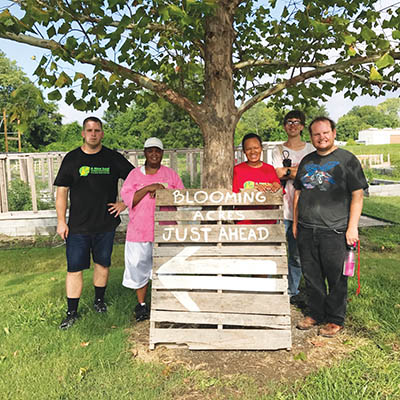 A New Leaf
A New Leaf
In Broken Arrow, A New Leaf is another kind of green nonprofit. There, they serve individuals with developmental disabilities by providing horticultural therapy, job training, and life-skills coaching. With six greenhouses and a two-acre production garden, A New Leaf’s clients and employees are in high gear this time of year. Kevin Harper, the organization’s director of marketing and business development, says that teaching their clients their values is as high-priority as teaching them job skills.
“We only sell half of what we grow; the rest is going to a food desert or to the food bank,” Harper said. “We like to teach our clients a holistic view about what we’re doing, that we earn a wage but we give back, too.”
This includes a can-do approach to sustainable horticulture. A New Leaf seeks grants and financial support for growing methods that are more sustainable than traditional soil systems. They have utilized a rainwater collection system and are also petitioning for the use of the creek near their Broken Arrow property for irrigation.
The future at A New Leaf includes the installation of an aquaponics system in one of six greenhouses. They are hopeful that the system, which grows fish and plants together, will increase their food production. They are also working on becoming more equipped to teach clients progressively efficient growing methods, like An Acre in a Box, a hydroponics system with customizable growing stations enclosed in a shipping container.
“The first thing is to make sure it’s good for our clients,” Harper said. “The Acre in a Box is perfect because we can make [the aisles and growing stations] the exact size for wheelchairs, so it increases the job opportunities for those clients.”
A New Leaf is also home to Blooming Acres, a two-acre farm dedicated to Community Supported Agriculture (CSA) shares. The vocational employees are involved in all steps from planning to packaging, including weekly delivery to the doorsteps of shareholders. The farm is not organic—certification is the main challenge—but their growing practices are very similar to organic farming procedures.
“Some of our clients have very sensitive allergies, so we’re very careful what we use, and we are very natural in how we do things,” Harper said.
A New Leaf’s greenhouses in Broken Arrow are open to the public for plant purchases. You can also find them throughout the growing season at their pop-up location in the parking lot at the northwest corner of 51st Street and Sheridan Road. Visit anewleaf.org for more information about purchasing CSA shares. —Kara Bellavia
A New Leaf Retail Garden Center
2405 S. Elm St., Broken Arrow
Saturday 9 a.m.–5 p.m. | Sunday 12 p.m.–5 p.m.
A New Leaf Pop-Up Shop
N.W. corner of 51st St. and Sheridan Rd.
Monday–Friday 9.am.–6 p.m.
Saturday 9 a.m.–5 p.m. | Sunday 12 p.m.–5 p.m.
Composting 101
You should be composting. Never heard of it? It’s the process by which organic material decomposes, right in your backyard.
Why? It has many benefits: It’s a great way to cut down on food waste, it can improve the quality of your soil, and it can reduce your reliance on store-bought fertilizers. It’s also simple, requiring only a few things to get started.
While pre-made compost bins are available at home and garden stores, you can make your own at home with a few materials. Start with an old plastic trash bin (or something similar). Drill a few holes in the sides, lid, and bottom. This will create a healthy amount of airflow and will allow helpful microbes and bugs in to help break down your material. If this sounds like too much work, an open-air compost pile is also feasible but will not provide the same protection from pests as a covered bin.
There are two kinds of compostable materials: brown and green. Brown materials are things like dried leaves, sawdust, hay, or even shredded papers. Who wouldn’t want to dispose of their incriminating documents in an environmentally friendly way? These materials are dry and are a good source of carbon for your compost. Green materials include vegetable scraps, coffee grounds, fruit peels, lawn clippings, bad cooking, or any other organic material containing lots of water. These are sources of nitrogen, another key ingredient.
But there are some things you should not add to compost. Wood can take years to decompose, slowing down the composting process significantly. Meat, milk, oil, and animal products can make your compost smell terrible and attract unwanted pests like rats. Human and animal waste are off the table, as well. (No shit? No shit.)
A ratio of two-thirds brown, one-third green material in your compost is recommended. It is not necessary to maintain this ratio exactly, but it is better to be heavier on brown materials, as these will keep your compost from becoming too dense, which slows down decomposition. After collecting your materials, add them to the bin and make sure they are mixed well.
Once you have everything together in one place, nature will begin its disgusting, miraculous work. You can help this process along by making sure the compost stays fairly moist. (It should be about as wet as a wrung-out sponge.) Additionally, you should turn and stir the compost every one to two weeks. This will ensure that everything is evenly mixed and will help build an emotional bond between you and the compost.
In reasonably warm weather it should take you four to six months to create usable compost. Fully composted materials will be dark brown and will not generate heat. They can be added to garden soil to improve fertility, allow drainage in dense earth, and help with water retention in sandy soil. —Fraser Kastner
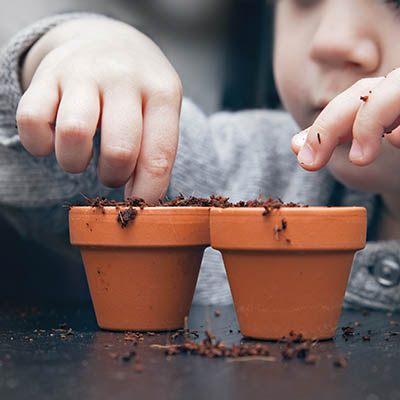 Global Gardens
Global Gardens
Tulsa-based Global Gardens is a youth gardening program that teaches kids about nutrition and science through the creation of on-site school and community gardens. Global Gardens was founded in 2007 by Heather Oakley, who came up with the idea while she was teaching at a school in Harlem and earning two master’s degrees in Urban Science Education and International Development/Peace Education at Columbia University.
“Global Gardens’ mission is to empower low-income students to be agents of change in their lives and communities through inquiry-based science and peace education,” said executive director Maryann Donahue in an interview with Tulsa World. “Essentially, we use the garden to teach kids how to solve problems—scientific, social, and intrapersonal. We are unique in that we blend science, peace, and empowerment in the garden setting. Another unusual aspect of our work is that we emphasize student-led inquiry.”
Global Gardens began at Eugene Field Elementary School in West Tulsa and has since expanded into three additional sites, Rosa Parks Elementary School, Union Middle School, and McAuliffe Elementary School. Global Gardens consists of during-school programs for children in kindergarten through fifth grade, after-school programs for third–sixth graders, family food farms for engaging the entire family, and summer programming like weeklong summer camps.
Global Gardens hopes to expand into every low-income Tulsa school. Visit global-gardens.org for more information. —Mary Noble
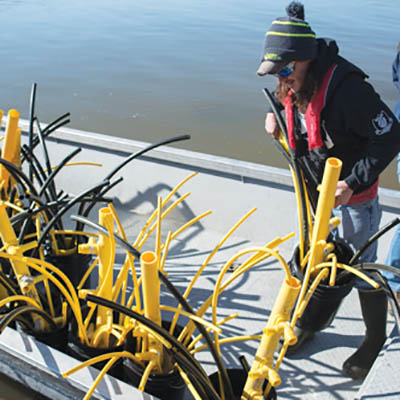 Fish Habitats
Fish Habitats
The polyethylene pipe used in the oil and gas industry has an expiration date. While most companies send their unused, out-of-date poly pipe to landfills, ONE Gas collaborated with the Oklahoma Department of Wildlife Conservation (ODWC) Northeast Region Fisheries Division on a project that put much of the pipe to positive use. Made to resemble trees, 125 fish habitat structures were constructed out of the pipe by securing short sections into buckets and concrete purchased by ONE Gas. Last year, habitats were placed at Grand Lake o’ the Cherokees. In March of this year, they were placed northeast of Tulsa in Spavinaw Lake. Much of the underwater brush that functions as fish habitat is deteriorating.
“When habitat is lacking, anything is good,” said Northeast Region Fisheries Supervisor John Johnston. Johnston described how periphyton and other single-cell organisms like algae collect on the pipe over time, providing food for smaller fish. These smaller fish attract bigger ones, augmenting the purpose of habitats so they’re not only aids in conservation but also tools for anglers.
Johnston described a new Geographic Information System program in development by the Fisheries Division that will eventually map all the aquatic habitats. Though it’s still being updated, the program is already live under “Where to Fish” and “Fish Attractor Locations Map” at wildlifedepartment.com.
The ODWC regulates and protects the fish population in Oklahoma by conducting surveys, selling fishing licenses and permits, and managing public fishing areas. Such efforts as the habitat construction with ONE Gas help the environment by reusing waste material in addition to serving the Oklahoma angling community. —Mason Whitehorn Powell
Up With Trees
Up With Trees’ origin sounds a bit like a folk tale. The organization has its roots in the early 1970s, when city commissioner Sid Patterson received a call from a high school boy who was concerned about trees that had been removed due to street construction. He wanted to know when those trees would be replaced. To see that they actually were, Patterson started Up With Trees, which has grown from an organization that primarily planted trees around the highway to one that has planted at least 32,000 trees around Tulsa, having expanded to city neighborhoods and parks. Up With Trees partners with various groups in the Tulsa community and focuses on improving Tulsa’s treeline. Their efforts include ReGreen Tulsa, a program to plant 20,000 trees in response to the 2007 ice storm and, more recently, a targeted effort to improve the foliage of the Osage Prairie Trail. Up With Trees also hosts Farmer’s Market events and Herb Day in Brookside and distributes thousands of seedlings to help better Tulsa’s urban canopy coverage. The organization often hosts classes in schools, with course material varying depending on the age of the students—but all courses invariably culminate in a planting on school grounds. Some of their big events include the Green Leaf Gala, which raises funds for year-round initiatives, and an annual two- or three-day tree trip in October, for which participants drive to a regional destination (they’re going to Nebraska City this year), observing and discussing the tree life there and on the way. Tulsans can join the Citizen Forester program, Up With Trees’ primary avenue for adult education in Tulsa. Visit upwithtrees.org for more information. —Trent Gibbons


.jpg)
.jpg)
